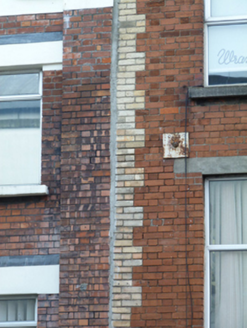Survey Data
Reg No
50020171
Rating
Regional
Categories of Special Interest
Architectural, Artistic, Historical, Social
Previous Name
Goodbody's
Original Use
Office
In Use As
Shop/retail outlet
Date
1890 - 1910
Coordinates
315720, 234136
Date Recorded
06/03/2015
Date Updated
--/--/--
Description
Attached three-bay three-storey former office, built c.1900, having shopfront to front (west) elevation. Now in use as shop. Hipped slate roof, set perpendicular to street, hidden behind stepped red brick parapet with render coping, cast-iron rainwater goods. Red brick, laid in Flemish bond, having string course and yellow brick quoins. Square-headed window openings with render sills, yellow brick voussoirs, or concrete lintel to first floor, replacement uPVC windows. Masonry shopfront comprising pilasters framing timber fascia, cornice, square-headed display windows and door opening to recessed porch, rendered steps, timber glazed door, overlight and sidelights. Located on east side of Fownes Street between Cope Street and Temple Bar.
Appraisal
Fownes Street was named after Sir William Fownes, Lord Mayor of Dublin in 1708. While the street was unnamed on Charles Brookings map of Dublin dating to 1728, a number of large houses are depicted on Fownes Street on John Rocque’s 1756 map of Dublin. In the mid-nineteenth century the Temple Bar area was characterised by industrial buildings and warehouses and Griffith’s Primary Valuation records this site as occupied by a house, printing office and yard. It was occupied by J & L Goodbody’s jute spinners when structural alterations were undertaken in 1929 by O’Callaghan & Webb. The brick façade is enlivened by the addition of polychrome brick dressings, and by a simple but well-executed shopfront with timber lettering, which lends contextual as well as artistic interest to the façade.

















